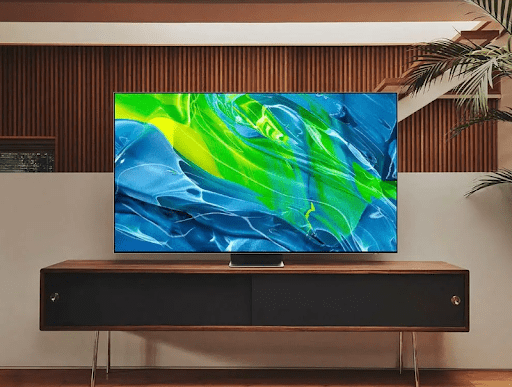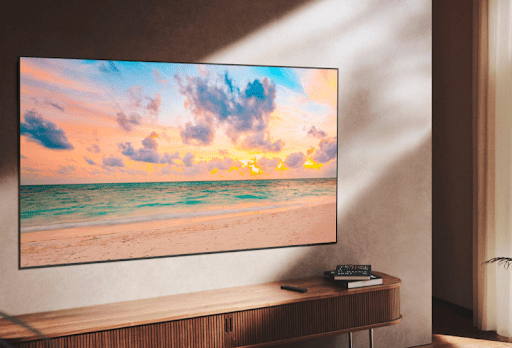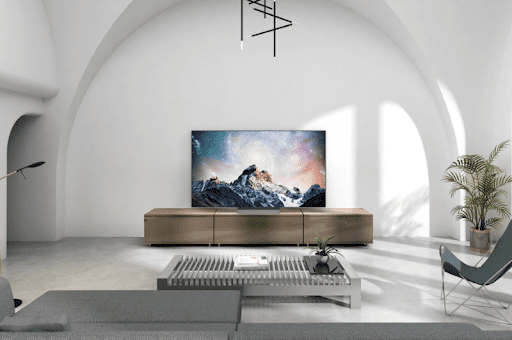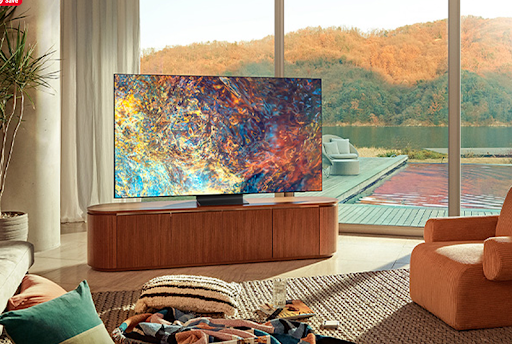Does laying on the sofa with a snack in your hand while watching TV, sound like your favourite pastime? A new TV can help bring your favourite movies and shows to life in a spectacular way. But with all the TV models available on the market, how can you tell which one will give a fantastic picture and offer a variety of additional advantages?
When searching for your next TV, you’ll notice two acronyms sticking out: QLED and OLED. And while new TV technology like QD-OLED by Samsung has been turning some heads lately, QLED and OLED TVs are still dominating the market. But how do they differ?
QLED (quantum dot LED) and OLED (organic light-emitting diode) are both terms used to describe display technologies employed in televisions. The main difference between the two is how they produce light.
How Does OLED Work?

OLED televisions have a layer of organic materials that, when exposed to an electric current, emit light. Since every pixel in an OLED display can turn on and off individually, this results in perfect blacks and infinite contrast. OLED TVs often have a wider viewing angle and are more energy-efficient than other types of TVs.
How Does QLED Work?

Quantum dots, a layer of tiny semiconductor crystals used in QLED TVs, are activated by a blacklight to produce light. This means that while QLED TVs can still generate extremely high levels of brightness and colour accuracy, they do not offer the same immaculate blacks and infinite contrast as OLED TVs. In comparison to OLED TVs, QLED TVs are often more robust and have a longer lifespan.
What Is the Difference in Terms of Picture Quality?
Due to their immaculate blacks and infinite contrast, OLED TVs are often thought of as the best option in terms of picture quality. However, QLED TVs are frequently cheaper than OLED TVs and can also generate extremely high brightness and colour accuracy levels. Furthermore, the local dimming feature of QLED TVs gives them an advantage over OLED TVs. This function separates the screen into smaller parts, each with its own LED backlight. Deeper blacks are possible as a result, and picture control is improved.
When it comes to endurance and longevity, QLED TVs are regarded as more dependable than OLED TVs. OLED TVs are vulnerable to burn-in and picture retention when the same image is shown on the screen for an extended length of time. These problems do not occur with QLED TVs.
Reasons to Buy an OLED TV

To Experience a Wide Viewing
No matter where you are positioned with respect to an OLED TV screen, you should be able to see what is happening. OLED TVs have unusual features and broad viewing angles that allow for a wide viewing experience.
Some OLED TV models have up to 8.3 million dimmable or entirely deactivatable self-illuminating pixels that can produce vivid colours and dramatic contrast. Some models feature an AI-powered processor that improves scenes pixel by pixel.
To Get the Most Contrast
OLED TVs have high contrast capabilities, making them ideal for environments with poor light. So, if you’re looking for a TV for a home theatre or primarily for nighttime viewing, this is the way to go. You’ll be better able to see darker backgrounds, and the overall quality of the image will be improved as well.
Image retention or burn-in is the main issue with OLED picture quality to take into account. Because its pixels are constantly being used, the TV then has an afterimage that persists or is permanent. By turning off your TV now and then, you’ll get to experience the OLED contrast and visual quality without burning in. Keep in mind that manufacturers have included safety features in more current OLED TVs, so if you decide to buy an OLED TV, be sure to get one from the current generation.
Energy Efficient
OLED panels don’t need a backlight that is extremely bright. This means OLED TVs are inherently more energy-efficient due to the less amount of power their backlights consume. They also generate less heat as compared to QLED TVs.
Eye Comfort
It’s feasible to spend hours watching TV without taking breaks in today’s viewing culture. Eye fatigue is an actual sign of the act and is typically brought on by the overproduction of blue light. Even in environments without a tonne of blue light, LED-based sets typically display the most intense blue light of any type of display. If you push it too far, your agitated eyes may eventually result in insomnia, which can cause a variety of health issues. Because of this, some OLED manufacturers are now looking to have their panels certified as Eye Safe.
Because OLED emits substantially less blue light than QLED TVs with LED backlighting, in principle OLED TVs should provide greater overall eye comfort than QLED and any other LCD-based panel. It’s nothing a particular pair of glasses can’t handle, but OLED is your champion if you want to make sure you have the safest viewing experience you can without buying new glasses.
Reasons to Buy a QLED TV?

To Be Able to Watch TV in a Bright Setting
While OLED TVs make good additions to dark environments, QLED TVs suit pretty well sunny areas or next to windows. No matter what time of day it is, you can watch your preferred programme on a QLED TV thanks to its high brightness levels.
HDR Support
Support for High Dynamic Range (HDR) is one of the key draws of purchasing a QLED TV. Through the use of HDR technology, brighter, more realistic, and more brilliant colours may be seen onscreen. As a result, this produces a viewing experience that is immersive and lifelike.
The HDR features of QLED TVs allow them to display images with a greater dynamic range and colour depth. They are therefore perfect for watching movies and TV shows that were specially made in HDR format. You’ll see vibrant, theatrical colours that jump off your screen as well as more vivid details.
You Want a More Affordable TV
Television is not valued equally by all people. A QLED TV will serve your needs better than an OLED TV if you’re looking for a less expensive TV due to a limited budget or the fact that you won’t be using it frequently.

































